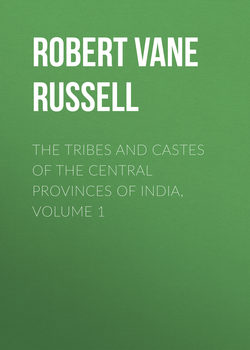Читать книгу The Tribes and Castes of the Central Provinces of India, Volume 1 - Robert Vane Russell - Страница 58
Part I.
Introductory Essay on Caste
Introductory Essay on Caste
55. Primitive language
ОглавлениеIt has been seen that primitive man considered the life and qualities to be distributed equally over the body in a physical sense, so that they formed part of the substance and flesh. The same view extended even to instrumental qualities or functions, since his mental powers and vision were necessarily limited by his language. Language must apparently have begun by pointing at animals or plants and making some sound, probably at first an imitation of the cry or other characteristic of the animal, which came to connote it. We have to suppose that language was at the commencement a help in the struggle for life, because otherwise men, as yet barely emerged from the animal stage, would never have made the painful mental efforts necessary to devise and remember the words. Words which would be distinctly advantageous in the struggle would be names for the animals and plants which they ate, and for the animals which ate them. By saying the name and pointing in any direction, the presence of such animals or plants in the vicinity would be intimated more quickly and more accurately than by signs or actions. Such names were then, it may be supposed, the first words. Animals or plants of which they made no use nor from which they apprehended any danger, would for long be simply disregarded, as nothing was to be gained by inventing names for them. The first words were all nouns and the names of visible objects, and this state of things probably continued for a long period and was the cause of many erroneous primitive conceptions and ideas. Some traces of the earliest form of language can still be discerned. Thus of Santāli Sir G. Grierson states: “Every word can perform the function of a verb, and every verbal form can, according to circumstances, be considered as a noun, an adjective or a verb. It is often simply a matter of convenience which word is considered as a noun and which as an adjective … Strictly speaking, in Santāli there is no real verb as distinct from the other classes of words. Every independent word can perform the function of a verb, and every verbal form can in its turn be used as a noun or adjective.”107 And of the Dravidian languages he says: “The genitive of ordinary nouns is in reality an adjective, and the difference between nouns and adjectives is of no great importance … Many cases are both nouns and verbs. Nouns of agency are very commonly used as verbs.”108 Thus if it be admitted that nouns preceded verbs as parts of speech, which will hardly be disputed, these passages show how the semi-abstract adjectives and verbs were gradually formed from the names of concrete nouns. Of the language of the now extinct Tasmanian aborigines it is stated: “Their speech was so imperfectly constituted that there was no settled order or arrangement of words in the sentence, the sense being eked out by face, manner and gesture, so that they could scarcely converse in the dark, and all intercourse had to cease with nightfall. Abstract forms scarcely existed, and while every gum-tree or wattle-tree had its name, there was no word for ‘tree’ in general, nor for qualities such as hard, soft, hot, cold, etc. Anything hard was ‘like a stone,’ anything round ‘like the moon,’ and so on, the speaker suiting the action to the word, and supplementing the meaning to be understood by some gesture.”109 Here the original concrete form of language can be clearly discerned. They had a sufficiency of names for all the objects which were of use to them, and apparently verbal ideas were largely conveyed by gesture. Captain Forsyth states110 that though the Korkus very seldom wash themselves, there exist in their language eight words for washing, one for washing the face, another for the hands and others for different parts of the body. Thus we see that the verbal idea of washing was originally conceived not generally, but separately with reference to each concrete object or noun, for which a name existed and to which water was applied.
107
Linguistic Survey of India, vol. iv., Munda and Dravidian Languages, pp. 40, 41, 45.
108
Linguistic Survey of India, vol. iv., Munda and Dravidian Languages, pp. 292, 294.
109
Dr. A.H. Keane, The World’s Peoples, London, Hutchinson, 1908, p. 50.
110
Nimār Settlement Report.
